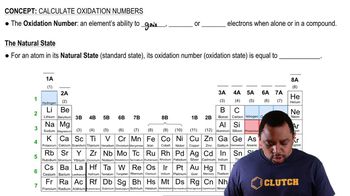Here are the essential concepts you must grasp in order to answer the question correctly.
Oxidation Numbers
Oxidation numbers are a way to keep track of electrons in chemical compounds. They indicate the degree of oxidation of an atom in a molecule, helping to determine how electrons are distributed among atoms. The oxidation number can be positive, negative, or zero, depending on the atom's electron gain or loss relative to its elemental state.
Recommended video:
Rules for Assigning Oxidation Numbers
There are specific rules for assigning oxidation numbers, such as: the oxidation number of an element in its standard state is zero, the oxidation number of a monoatomic ion equals its charge, and in compounds, the sum of oxidation numbers must equal the overall charge of the molecule or ion. These rules provide a systematic approach to determine the oxidation states of each element in a compound.
Recommended video:
Polyatomic Ions
Polyatomic ions are ions composed of two or more atoms that are covalently bonded and carry a net charge. In the case of AsO4 3-, the arsenate ion consists of one arsenic atom and four oxygen atoms, with a total charge of -3. Understanding the structure and charge of polyatomic ions is essential for correctly assigning oxidation numbers to their constituent elements.
Recommended video:
Polyatomic Ion Variations

 Verified step by step guidance
Verified step by step guidance


